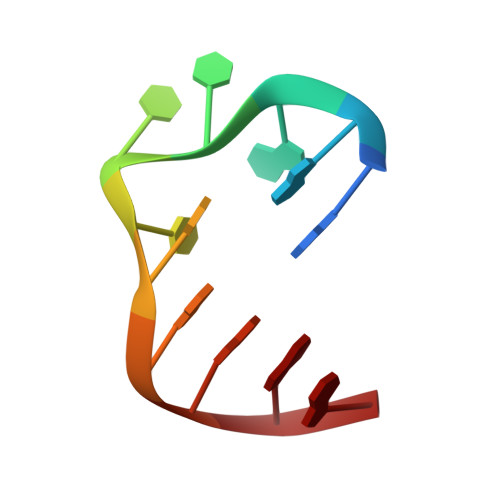d(G3T4G4) forms unusual dimeric G-quadruplex structure with the same general fold in the presence of K+, Na+ or NH4+ ions.
Sket, P., Crnugelj, M., Plavec, J.(2004) Bioorg Med Chem 12: 5735-5744
- PubMed: 15498650
- DOI: https://doi.org/10.1016/j.bmc.2004.08.009
- Primary Citation of Related Structures:
1U64 - PubMed Abstract:
We have recently communicated that DNA oligonucleotide d(G(3)T(4)G(4)) forms a dimeric G-quadruplex in the presence of K(+) ions [J. Am. Chem. Soc.2003, 125, 7866-7871]. The high-resolution NMR structure of d(G(3)T(4)G(4))(2) G-quadruplex exhibits G-quadruplex core consisting of three stacked G-quartets. The two overhanging G3 and G11 residues are located at the opposite sides of the end G-quartets and are not involved in G-quartet formation. d(G(3)T(4)G(4))(2) G-quadruplex represents the first bimolecular G-quadruplex where end G-quartets are spanned by diagonal (T4-T7) as well as edge-type loops (T15-T18). Three of the G-rich strands are parallel while one is anti-parallel. The G12-G22 strand demonstrates a sharp reversal in strand direction between residues G19 and G20 that is accommodated with the leap over the middle G-quartet. The reversal in strand direction is achieved without any extra intervening residues. Here we furthermore examined the influence of different monovalent cations on the folding of d(G(3)T(4)G(4)). The resolved imino and aromatic proton resonances as well as (sequential) NOE connectivity patterns showed only minor differences in key intra- and interquartet NOE intensities in the presence of K(+), Na(+) and NH(4)(+) ions, which were consistent with subtle structural differences while retaining the same folding topology of d(G(3)T(4)G(4))(2) G-quadruplex.
Organizational Affiliation:
NMR Center, National Institute of Chemistry, Hajdrihova 19, SI-1000 Ljubljana, Slovenia.














